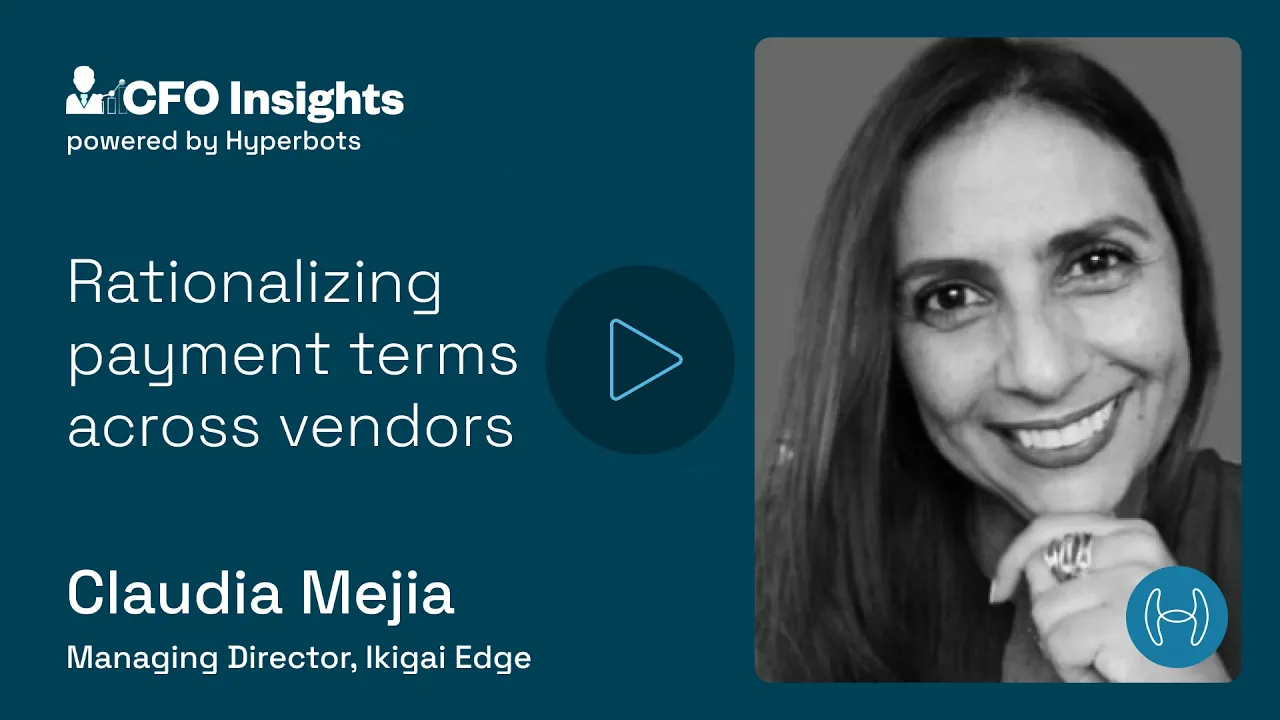
Payment
Vendor Management
Rationalizing payment terms across vendors
Find out interesting insights with Claudia Mejia,Managing director, Ikigai Edge.
Moderated by Srishti, Digital Transformation Consultant at Hyperbots
Don't want to watch a video? Read the interview transcript below.
Srishti: Hello, everyone! My name is Srishti Rajvir, and I am a digital transformation consultant at Hyperbots today. I'm delighted to have Claudia Mejia as my guest. Thank you so much for taking the time, Claudia.
Claudia Mejia: Hi, Srishti, thank you. Good to see you again.
Srishti: Absolutely. It's an absolute pleasure to always have you here, and I love having these conversations with you. So just a little bit about Claudia for the audience—she is the managing director at Ikigai Edge, and today we'll be discussing the topic of payment terms rationalization across vendors. Whenever you're ready, Claudia, we can get started.
Claudia Mejia: You're right. Let's go.
Srishti: Alright. To start off with, what is payment term rationalization? And why is it important for businesses?
Claudia Mejia: Payment terms rationalization is the standardization and alignment of payment conditions across vendors. We usually do this when we consolidate categories. That way, it's easier to standardize these practices. What it helps with is reducing complexity, improving cash flow forecasting, and ensuring consistency. At the end of the day, it's about financial efficiency and vendor relationships, and all these things help to achieve that.
Srishti: Understood. Which payment terms can be rationalized among vendors in a similar class of purchases?
Claudia Mejia: There are a couple of things that can be rationalized. For example, the net days. Sometimes companies use net 30, net 45, or even net 60, depending on the vendor category. Early payment discounts can also be standardized, such as 2% if paid within 10 days, or defaulting to net 30 otherwise. Late payment penalties are important to set up in contracts as well. Lastly, payment methods should be considered, as they may come with additional fees or conditions.
Srishti: Understood. Moving on to the next question—how can rationalizing payment terms benefit a company?
Claudia Mejia: Ideally, we want to improve cash flow. When we have consistency and standardized payment terms, we can better plan cash management. Operational efficiency is another benefit, as it reduces complexity in payment administration, helping us allocate resources better.
Vendor management also improves because standardization enhances negotiations and allows us to leverage terms across multiple vendors. At the end of the day, it's about cost savings. Efficient cash management ensures we are directing payments optimally.
Srishti: That's very interesting. Thank you for sharing your insights on that. Now, onto the next question. Can you explain the steps involved in rationalizing payment terms across similar vendors?
Claudia Mejia: We usually start by collecting data from all vendors. We categorize them based on the type of services or purchases. Then, we benchmark the payment terms against industry standards and best practices. Next, we engage with business units, procurement teams, and finance to align on potential changes to payment terms. After that, we negotiate with vendors. Some negotiations are straightforward when we have data-backed insights, but others can be more complex, especially with long-term contracts. Once agreements are reached, we implement changes. This involves updating contracts, and internal systems, and ensuring a smooth change management process. Finally, we monitor performance to ensure vendors adhere to the new standardized terms.
Srishti: That is extremely helpful. Now, moving on—what challenges might arise when standardizing payment terms, and how can they be addressed?
Claudia Mejia: One challenge is vendor resistance. If a vendor has been working with a company for a long time under specific terms, they may be reluctant to change. However, providing data-driven justifications and clear communication can help mitigate this. Contractual limitations can also pose challenges, especially when dealing with long-term agreements. Flexibility and phase transitions can help address this issue. Ultimately, to mitigate these challenges, we need to be flexible, communicate effectively, and collaborate closely with vendors.
Srishti: That's very interesting. What role does AI play in identifying rationalization opportunities for payment terms?
Claudia Mejia: AI can spot inconsistencies. If a company has multiple vendors with unstandardized terms, AI can identify discrepancies across similar service categories. It can also benchmark these terms against industry standards, helping companies make data-driven decisions. Additionally, AI can predict the financial impact of changes by modeling different scenarios and their effects on cash flow. By automating data collection and analysis, AI can recommend optimal payment term adjustments, improving efficiency and financial planning.
Srishti: That's really helpful. Thank you for sharing your insights on that. Now, onto the last question—can you provide an example of how Hyperbots' Payment AI Copilot has helped rationalize payment terms?
Claudia Mejia: Hyperbots' AI collects data, identifies discrepancies in terms and discounting, and provides actionable recommendations. For example, if a company has vendors offering net 45 terms but industry benchmarks suggest net 30 with early payment discounts, the AI will flag this and recommend adjustments. By aligning terms across similar vendors, companies can optimize cash flow, reduce administrative complexity, and improve financial planning.
Srishti: Thank you so much for sharing that. We have come to the end of today's discussion. Thank you for joining us, Claudia. It is always lovely to have you here, and a big thanks to our viewers. I'll see you around. Have a good one. Goodbye.
Claudia Mejia: Thank you.

